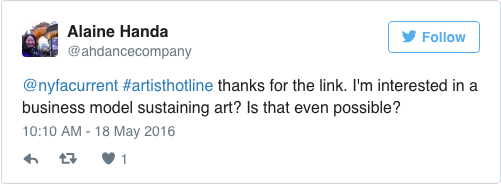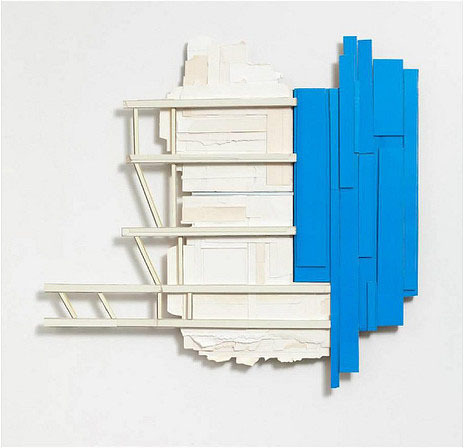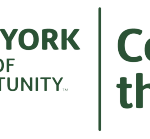Ask #ArtistHotline: How Can a Business Model Sustain Art?
Having an innovative business model can give you a competitive edge. But even more importantly, it gives you a chance to find a system that’s authentically you.
Each month, artists and arts professionals flock to Twitter for #ArtistHotline to discuss the Business of Art. During this monthly tweet chat, we often explore how artists can supplement their creative practice with business savvy.
Alaine Handa, in that entrepreneurial spirit, asked about business models during May’s #ArtistHotline.

Our answer is an enthusiastic yes. It is possible, and oftentimes advantageous, to integrate the arts into a business model, or to apply a business model framework to your creative practice. To that end, we’re offering a business model primer for artists, arts organizations, and for-profit ventures with active arts programming. We’ll cover the following topics:
- Business models: what are they?
- Tips for creating and tweaking a business model
- A case study for individual artists
- A case study for organizations and businesses
At NYFA, we believe there are lots of paths to take as an artist, and a multitude of ways to think about the business of your art. Some artists support their art through a day job or through grants and fellowships, while others strive to make their creative practice self-sustainable. This particular article will focus on strategies for those artists who would like to use their art to generate income.
Business Models: What are They?
“Business model” is a common, everyday phrase, but, in spite of its widespread use, or maybe because of it, its meaning has become somewhat fuzzy.
At its most basic, a business model is a plan for generating revenue. It “answers the question, ‘How are we going to make money to survive and grow?’” (BusinessDictionary.com). A business model can be divided into two parts: first, your product and the work that goes into its production, like a sculpture and the raw materials used to create it. The second part of a business model involves identifying and building your audience, getting your art out in the world, and potentially making sales. Many artists have a business model, but it may be more of a loose idea than an explicit, detailed plan.
Creating a business model is an exercise in storytelling. According to Joan Magretta, writing for the Harvard Business Review, business models are “at heart, stories—stories that explain how enterprises work. A good business model answers [the] age-old questions, ‘Who is the customer? And what does the customer value?’”
The artist is no stranger to storytelling. Some artists utilize the basic structure of a story—a beginning, middle, and end—as a framework for creating. Others may explore archetypal plots, like “Overcoming the Monster” or “Rags to Riches,” adapting these storylines to their own unique vision. Still others defy expectations by disrupting the traditional storyline.
Here are some tips for creating or finetuning your business model.
I. Fill the Canvas
The business model canvas can help you look at a variety of factors simultaneously by answering the following questions:
- Who are my key partners and suppliers?
- What is my value proposition, or what makes my product or service valuable to my audience? What problem am I solving for my audience members, or what need am I fulfilling/meeting?
- What are the necessary activities and materials?
- How do I build my audience and maintain relationships with existing audience members?
- Who is my audience?
- What are the best ways, or channels, to communicate with my audience and get my work out there?
- Which resources and activities are the most expensive? Which are the most important?
- What are my current streams of revenue, and how can I create new ones?
Using a business model canvas is a great way to examine your implicit assumptions about what your audience wants, how much everything will cost, and most essentially, what kind of work or service or experience is valuable to your audience.
II. Make it New
Most successful value propositions involve doing things differently. As Magretta says, “A new business model may turn on designing a new product for an unmet need or on a process innovation.” Betsi Graves started Urbanity Dance not because she wanted to make money, but because, as she told us, she saw “a tremendous void in Boston for contemporary dance education, performance, and community.” Another artist, Ashley Longshore, achieved a “process innovation” when she created Artgasm, using a subscription model to cut out the middleman in selling her work.
Having an innovative business model can give you a competitive edge and help you stand out. But even more importantly, it gives you a chance to find a system that’s authentically you. In the words of Deborah Fisher, Executive Director of a blade of grass:
Arts entrepreneurship means recognition of new forms art can take … Artists that recognize … forms of daily life as fertile playgrounds for artistic transformation are reaching new audiences in deep and innovative ways that keep the artists themselves in control of their own value proposition and market; model new roles for artists in society; and expand our sense of what art is, who it’s for and what it does.
Answering questions like, “who is my audience?” and “what is my value proposition?” is a chance to reflect on what you want from the business side of your practice.
III. “Call me a Chameleon.” – Meat Loaf
The business model canvas is a tool you can, and should, revisit often. A business model is like a hypothesis that needs to be tested over and over again, and sometimes tweaked or revamped. This kind of constant re-evaluation can help you finetune your plan and adapt to changes in the market. A business model canvas for an individual artist or arts organization from 2007, for example, would look very different from one drawn up today.
After the recession, many arts organizations needed to rethink their audience development tactics. TRG Arts describes how several theaters examined their revenue streams that were already successful, or that could potentially bring in more income; doing this caused them to focus more on retaining existing audience members instead of securing new ones.

Case Study I: the Individual Artist
Visual artist Shantell Martin has developed a unique revenue model over the years. She observes that “the art world limits who gets in and who doesn’t get in. So when that’s the case, you have to create your own models … I like to say, if there are no doors, go out a window.“
Faced with a lack of interest from galleries when she first moved to New York, she made the unique choice of taking galleries out of the formula, concentrating more on residencies, collaborating, and throwing her own events.
As Martin became more well known, galleries approached her, but she turned them down. Some artists might wonder at this decision, but her story shows how an artist or organization can create a model that best fits their work and who they are. Martin often uses the hashtag #AREYOUYOU, which is a good reminder that the process of creating a business model presents numerous opportunities to reflect on who you are and which revenue streams or opportunities work best for you. In Martin’s case, she’s been able to support her work through residencies, teaching, and collaborations with different brands.
Case Study II: Ventures in Hospitality
Organizations and businesses can also balance creativity with smart commercial decisions. The hospitality industry in particular offers several examples.
The Cloud Club in Boston consists of two brick townhouses that are ever-evolving works of arts, as well as live-in studios. The Cloud Club presents curated events, has a movie theater, and is a place for artists to collaborate. In New York, the Roger Smith Hotel provides guests with an arts guide and also hosts events like Show & Tell, a storytelling series, as well as openings in their rotating gallery spaces.
Wythe Hotel is another example of how a business can take savvy steps to foster the arts in the workplace. In a recent piece in Brooklyn Magazine, How Did Wythe Hotel Become An Incubator For Artists?, Kimia Ferdowsi Kline, a Basil Alkazzi Artist in Residence, as well as the hotel’s curator, discusses how Wythe became a “home base” for her. In part, that was because of the hotel’s flexible scheduling, which allows the artists who work there to take advantage of opportunities like residencies.
Wythe Hotel shows that supporting the arts can be a good marketing tactic. But it also demonstrates that a good business model can unify employees. As Joan Magretta would say:
Because a business model tells a good story, it can be used to get everyone in the organization aligned around the kind of value the company wants to create. Stories are easy to grasp and easy to remember. They help individuals to see their own jobs within the larger context of what the company is trying to do …
This story can then enhance a customer’s experience and cement a business’s reputation. The owners of Wythe Hotel, for example, chose to build the hotel’s collection by gradually purchasing one-of-a-kind pieces, instead of in bulk. This created the opportunity to host openings for the new art, and, as Kline says, “‘to extend this creative story past our walls and into the Brooklyn community.’”
Business Model: A Term of Art
It’s fitting that financial journalist Michael Lewis says that business model is “a term of art.” The art entrepreneurship skills that go into creating a business model are likely to benefit you professionally and artistically.
How have you tweaked your business model? Chime in on Twitter during #ArtistHotline, every third Wednesday of the month.
Inspired by the NYFA Source Hotline, #ArtistHotline is a new initiative dedicated to creating an ongoing online conversation around the professional side of artistic practice. #ArtistHotline occurs on the third Wednesday of each month on Twitter. Our goal is to help artists discover the resources needed, online and off, to develop sustainable careers. Please join us for the next #ArtistHotline discussion on July 20.
This initiative is supported by the Emily Hall Tremaine Foundation.
– Mirielle Clifford, Program Associate, Online Resources
Images, from top: Jessica Segall (Fellow in Crafts/Sculpture ‘14), Paradise Begins With A Shipwreck, 2013; Ryan Sarah Murphy (Fellow in Crafts/Sculpture ‘14), Fixed Departure, 2011.





